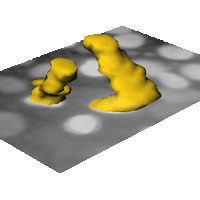Evolutionary snake algorithms for biological applications
2008
Master Semester Project
Project: 00167

In many bioimaging applications, capturing the dynamics of processes in living cells is an important problem. Tracking living cells in a video sequence of a biological sample can lead to effective quantitative analysis that gives us more insight into the functional behaviour of the cell. Detecting rare events can sometimes be suggestive of functional heterogeneity. Object tracking is a recurring theme in molecular and cellular image analysis, with newer challenges arising out of different imaging modalities. Typically, biologists do it manually, a task that becomes very tedious if the data sizes are huge. With the availability of many modern table-top imaging systems, the amount of biological data is just too huge to be able to harness manually. Thus, there is an ever-growing demand for automatic algorithms, mainly because they minimize manual labour and aid in objective scientific analysis. At our laboratory, the emphasis is on mathematical aspects of image analysis. Our earlier research works have shown that B-spline active contour models (also known as snakes) are effective for outlining objects in images. Coupled with evolutionary (in time) algorithms, snakes can offer a very good solution for the tracking problem. The objective of this project is to develop algorithms for evolutionary B-spline snake algorithms and to also validate their performance on real images.
The project student will be required to develop new snake algorithms and program them in ImageJ.
- Supervisors
- Daniel Sage, daniel.sage@epfl.ch, 021 693 51 89, BM 4.135
- Michael Unser, michael.unser@epfl.ch, 021 693 51 75, BM 4.136
- Chandra Sekhar Seelamantula